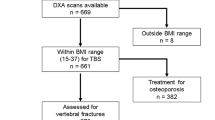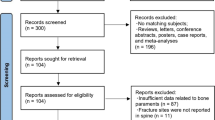Abstract
Objective
Osteoporosis is diagnosed based on the results of BMD assessment and/or fragility fractures. Vertebral fracture is the most common fragility fracture. Many vertebral fractures are asymptomatic and are not clinically recognized. Early detection of vertebral fracture may increase diagnosis of osteoporosis. In this study, we performed BMD measurement combined with vertebral fracture assessment (VFA) by DXA for the postmenopausal women receiving the first bone densitometry and studied the impact of VFA on the diagnosis of osteoporosis.
Methods
A total of 502 postmenopausal women were enrolled in our study. Patients’ age was 66.7 ± 9.5 years. All patients had BMD assessment and VFA by dual-energy X-ray absorptiometry. Genant’s semiquantitative assessment was used. The impact of VFA on the diagnosis of osteoporosis was studied. All parameters of groups were compared using the Chi-squared test.
Results
There were 257 patients with T-score ≤−2.5, 202 patients with a T-score between −1 and − 2.5, and 43 patients with BMD within the normal range. There were 162 patients with 345 fractured vertebrae identified by VFA, among which 84% of patients were previously unknown. Osteoporosis or severe osteoporosis was presented in 51.2% patients diagnosed by BMD alone, in 55.2% patients diagnosed by BMD plus fracture history, and in 62.4% of patients diagnosed by BMD plus fracture history and VFA. Severe osteoporosis significantly increased by 17.2% in patients receiving VFA.
Conclusions
VFA combined with BMD can detect previously unknown vertebral fractures and increase clinical diagnosis of osteoporosis. It is plausible to speculate that this method should be considered in postmenopausal women for the first BMD assessment.



Similar content being viewed by others
Abbreviations
- BMD:
-
Bone mineral density
- DXA:
-
Dual-energy X-ray absorptiometry
- VFA:
-
Vertebral fracture assessment
- ISCD:
-
International Society for Clinical Densitometry
References
Kanis JA, Borgstrom F, De Laet C, Johansson H, Johnell O, et al. Assessment of fracture risk. Osteoporosis Int. 2005;16(6):581–9.
Kanis JA, McCloskey EV, Johansson H, Cooper C, Rizzoli R, Reginster JY. European guidance for the diagnosis and management of osteoporosis in postmenopausal women. Osteoporos Int. 2013;24(1):23–57.
Compston J, Cooper A, Cooper C, Gittoes N, Gregson C, et al. UK clinical guideline for the prevention and treatment of osteoporosis. Arch Osteoporos. 2017;12(1):43.
Siris ES, Miller PD, Barrett-Connor E, Faulkner KG, Wehren LE, et al. Identification and fracture outcomes of undiagnosed low bone mineral density in postmenopausal women: results from the National Osteoporosis Risk Assessment. JAMA. 2001;286:2815–22.
Rosen HN, Vokes TJ, Malabanan AO, Deal CL, Alele JD, et al. The official positions of the International Society for Clinical Densitometry: vertebral fracture assessment. J Clin Densitom. 2013;16(4):482–8.
Genant HK, Wu CY, van Kuijk C, Nevitt MC. Vertebral fracture assessment using a semiquantitative technique. J Bone Miner Res. 1993;8(9):1137–48.
Siris ES, Adler R, Bilezikian J, Bolognese M, Dawson-Hughes B, et al. The clinical diagnosis of osteoporosis: a position statement from the National Bone Health Alliance Working Group. Osteoporos Int. 2014;25:1439–43.
Melton LJ, Chrischilles EA, Cooper C, Lane AW, Riggs BL. Perspective how many women have osteoporosis? J Bone Miner Res. 1992;7(9):1005–10.
Nguyen ND, Ahlborg HG, Center JR, et al. Residual lifetime risk of fractures in women and men. J Bone Miner Res. 2007;22(6):781–8.
The European Prospective Osteoporosis Study (EPOS) Group. Incidence of vertebral fracture in Europe: results from the European Prospective Osteoporosis Study (EPOS). J Bone Miner Res. 2002;17(4):716–24.
Waterloo S, Ahmed LA, Center JR, Eisman JA, Morseth B, et al. Prevalence of vertebral fractures in women and men in the population-based Tromsø study. BMC Musculoskelet Disord. 2012;13:3.
Lindsay R, Silverman SL, Cooper C, Hanley DA, Barton I, et al. Risk of new vertebral fracture in the year following a fracture. JAMA. 2001;285:320–3.
Delmas PD, Genant HK, Crans GG, Stock JL, Wong M, et al. Severity of prevalent vertebral fractures and the risk of subsequent vertebral and nonvertebral fractures: results from the MORE trial. Bone. 2003;33(4):522–32.
Delmas PD, van de Langerijt L, Watts NB, Eastell R, Genant H, et al. Underdiagnosis of vertebral fractures is a worldwide problem: the IMPACT study. J Bone Miner Res. 2005;20(4):557–63.
Li Y, Yan LS, Cai S, Zhuang H, Wang P, Yu H. The prevalence and under-diagnosis of vertebral fractures on chest radiograph. BMC Musculoskelet Disord. 2018;19:235.
Domiciano DS, Figueiredo CP, Lopes JB, Kuroishi ME, Takayama L, et al. Vertebral fracture assessment by dual X-ray absorptiometry: a valid tool to detect vertebral fractures in community-dwelling older adults in a population-based survey. Arthritis Care Res. 2013;65(5):809–15.
Van Dort MJ, Romme EAPM, Smeenk FWM, Geusens PPPM, Wouters EFM, van den Bergh JP. Diagnosis of vertebral deformities on chest CT and DXA compared to routine lateral thoracic spine X-ray. Osteoporos Int. 2018;29(6):1285–93.
Diacinti D, Del Fiacco R, Pisani D, et al. Diagnostic performance of vertebral fracture assessment by the lunar iDXA scanner compared to conventional radiography. Calcif Tissue Int. 2012;91:335–42.
Mrgan M, Mohammed A, Gram J. Combined vertebral assessment and bone densitometry increases the prevalence and severity of osteoporosis in patients referred to DXA scanning. J Clin Densitom. 2013;16(4):549–53.
Jager PL, Jonkman S, Koolhaas W, Stiekema A, Wolffenbuttel BHR, Slart RHJA. Combined vertebral fracture assessment and bone mineral density measurement: a new standard in the diagnosis of osteoporosis in academic populations. Osteoporos Int. 2011;22(4):1059–68.
Ehsanbakhsh AR, Akhbari H, Lraee MB, Toosi FS, Khorashadizadeh N, et al. The prevalence of undetected vertebral fracture in patients with back pain by dual-energy X-ray absorptiometry (DXA) of the lateral thoracic and lumbar spine. Asian Spine J. 2011;5(3):139–45.
Cui L, Chen L, Xia W, Jiang Y, Huang W, et al. Vertebral fracture in postmenopausal Chinese women: a population-based study. Osteoporos Int. 2017;28:2583–90.
Lee JH, Lee YK, Oh SH, Ahn J,Lee YE, et al A systematic review of diagnostic accuracy of vertebral fracture assessment (VFA) in postmenopausal women and elderly men. Osteoporos Int. 2016;27(5):1691–9.
Deleskog L, Laursen NO, Nielsen BR, Schwarz P. Vertebral fracture assessment by DXA is inferior to X-ray in clinical severe osteoporosis. Osteoporos Int. 2016;27(7):2317–2326.
Acknowledgements
We thank Miss Yuwei Sun for her textual revision of final manuscript.
Funding
This work was supported by grants from Fujian Province Health and Family Planning Commission (Grant No: 2015 CXB 18) and Quanzhou Science and Technology Bureau (Grant No:2014Z44). The funders had no role in study design, data collection and analysis, decision to publish, or preparation of the manuscript.
Author information
Authors and Affiliations
Corresponding author
Ethics declarations
Conflicts of interest
The authors declare that they have no conflicts of interest.
Ethical approval
The participants were informed at the time of BMD measurement that their data would be included in a research study, and provided written consent. Approval for this research was given by the ethics committee of the Second Affiliated Hospital of Fujian Medical University (ERAN No:2017–111).
Additional information
Publisher’s note
Springer Nature remains neutral with regard to jurisdictional claims in published maps and institutional affiliations.
Rights and permissions
About this article
Cite this article
Cai, S., Yu, H., Li, Y. et al. Bone mineral density measurement combined with vertebral fracture assessment increases diagnosis of osteoporosis in postmenopausal women. Skeletal Radiol 49, 273–280 (2020). https://doi.org/10.1007/s00256-019-03280-3
Received:
Revised:
Accepted:
Published:
Issue Date:
DOI: https://doi.org/10.1007/s00256-019-03280-3




